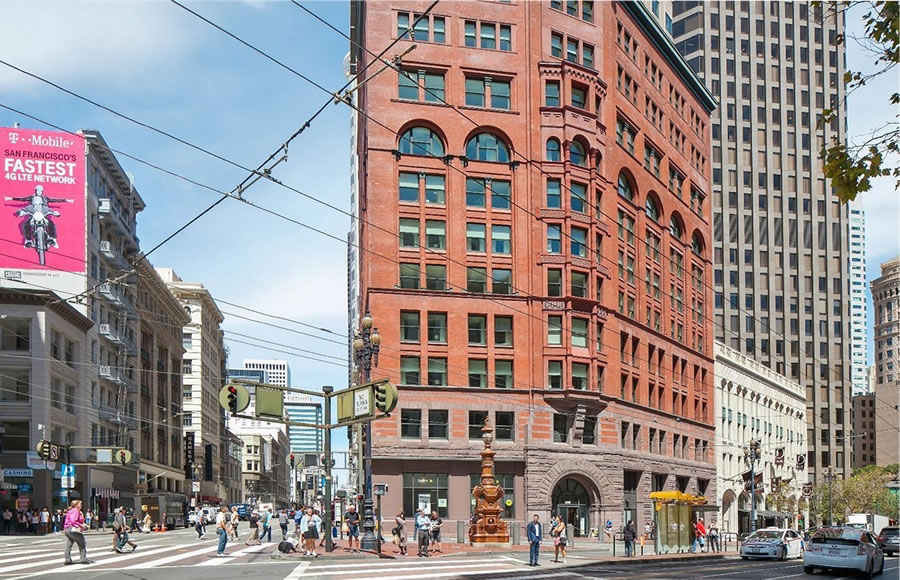As we outlined earlier this year:
Purchased as new for $1.53 million, or roughly $1,284 per square foot, in early 2008, right as the Great Recession was picking up steam, the two-bedroom Ritz-Carlton Residences unit #1702 at 690 Market Street returned to the market in early 2015 priced at $1.75 million.
Reduced to $1.65 million and then withdrawn from the market after being offered for rent at $8,500 a month, the condo was listed anew in 2017 with a $1.6 million price tag.
Reduced to $1.5 million [in July of last year] and then to $1.4 million in November, the list price for 690 Market Street #1702 has just been reduced again to $1.3 million (which is roughly $1,091 per square foot and 15 percent below the price which was paid for the unit in the first quarter of 2008, not accounting for the value of the all furnishings which are now included in the sale price as well).
And yes, having been financed in 2008 with 30 percent down and a loan for $1,065,540, the loan is now a little over $100,000 past due with a remaining balance of $1,015,514 and a foreclosure auction looming. Or in listing speak: “The timing is right!”
As we added in July:
Withdrawn from the MLS and then relisted anew at the end of June, with the unit having since been emptied of its aforementioned furnishings, a trustee deed having newly been granted to HSBC Bank and a new $1.2 million price tag, the list price for 690 Market Street #1702 has just been reduced another 5 percent to $1.14 million, or roughly $956 per square foot, a sale at which would now represent a 25.5 percent drop in value for the unit since the first quarter of 2008 (with some ups and downs between).
The price for the two-bedroom was reduced another 5 percent at the end of August. And having been virtually staged and further reduced to $1,028,850, the resale of 690 Market Street #1702 has just closed escrow with a contract price of $1,035,200.
And while that’s officially “over asking” according to all industry stats and reports, it’s also 32.3 percent below the unit’s 2008-era purchase price on an apples-to-apples basis and 40.8 percent below its 2015-era list/expectations.







Ouch. This will become increasingly typical (though not near so large) of resale’s going forward. The Chronicle headlined recently the Schwab move out of SF as part of an increasing exodus from the City of major employers. Even tech companies like Stripe are starting to leave. Job and population decreases coming and that will be the catalyst to further pop the SF RE boom which was overhyped to begin with and which could not have been sustained.
Let’s see how the prediction of “job and population decreases” plays out. I’d take the other side of that bet.
For some fun reading, go back and read the comments from 2008 when a lot of commenters thought SF would turn into Detroit.
@OG Lurker – I hope that was sarcasm, if not you are way off target. The only post I see from 2008 with the ‘690 Market’ tag is this one —
And the first comment on that thread is the most ill-timed, infamous bad bull call of SocketSite history (and probably the target of the most commenter ridicule):
“Posted by fluj – 11 years ago
It’s over. Sorry. Scare tactics are dead. San Francisco never really took a price hit and it won’t, either. Gee, this one bedroom SOMA condo only got $1.3M and not $1.5? Boo hoo.”
There were a few bears back then, but a whole hoard of bulls who thought the bubble would keep blowing forever. (And I don’t see anything on that thread about SF turning into Detroit, nor do I remember anyone arguing that)
I don’t get Dave’s love for grey, rainy and traffic clogged Seattle, but if you look at the population trends he’s got some good odds of being right about population.
I wonder if there’s a Ritz Carlton curse for bringing out bad bull calls… Wonder how “San Francisco never took a population hit and it won’t, either.” will look 11 year on from now..
I should have been more clear, I meant comments on the site as a whole. If I remember right, fluj was the token realtor, right?
Factually speaking, that’s incorrect. While there were more bears than bulls commenting back in 2008, and the bears were, in fact, directionally correct through 2011, the notion that San Francisco would turn into the next Detroit was a fringe position (at best).
I recall the most popular characters on here had a sentiment that the tech industry was going to shrink in SF. Quite the opposite happened!
There were actually two common refrains circa 2008: 1. Tech would insulate the housing market in San Francisco from a downturn; and 2. Tech would not insulate the housing market in San Francisco from a downturn (which, in fact, was the bingo).
Which brings us back to the market today.
Actually more like a bingo blend: fears that (what turned into) the Great Recession would be a repeat of the ‘Dotcom Crash’ vs. bluster that it wouldn’t; on the local level that optimism was somewhat true – ’08-’10 wasn’t nearly as traumatic as ’00-’04 (at least to the extent that employment is a proxy for the economy) – but clearly false – and then some !! – at the state/national level(s).
I think the editor has it right. Many people thought then (and now) that tech would insulate SF from a housing downturn. But that didn’t happen and SF housing took a big hit. I don’t recall many people saying that tech would take a hit in 2008. In the dotcom crash, tech and employment took bit hits but housing didn’t really. Rents maybe did. Makes sense that a tech bubble ended with a tech crash and a housing bubble (or two) ended (and will end) with a housing crash.
@OG Lurker — “If I remember right, fluj was the token realtor, right?” Mascot more than token I’d say. And I don’t think the past tense is the correct choice here, if you fire up your Juul pods and “parse” out some recent commentary.
Be aware that Seattle guy here has been calling doom on SF real estate for a long time. Furthermore, when the same down ticks happen in the Seattle index, he cites them as positive evidence of housing stock growth that should be celebrated. Given how prolific and single minded he is in the comments, I have to believe this is some kind of satire or SocketSite’s alter ego.
Needless to say, the population of SF is still increasing. (More slowly, yes, but still increasing.)
I don’t understand why Seattle Dude bothers to post here. He never has anything positive to say about anything. And apparently is not even from here.
Stripe moved less than 10 miles. Schwab not moving any jobs
I think the Seattle commenter above is quite a bit more pessimistic than I’d be. I think the market is cooling, for sure, but I don’t expect demand to dry up.
The story with this unit is the HOA dues of $2,800 per month. There are not many buyers for units in this price range who are equipped to spend that much on HOA. Those who are, probably have the wallets to buy a larger unit. This is a super-high-end luxury buyer who doesn’t mind dropping serious coin every month on amenities.
HOA dues have always been high at the Ritz, including back when this unit was purchased in 2008.
Previous Socketsite articles will tell you the HOA is high because the developer took away too many of the “historic walls” in the building during the remodel. Something about the historic status of it was compromised so the price went up. I’ve been watching this building since it was first starting to be a Ritz residential. Sad for the original buyers.
What?!?! I looked thru the 27 different posts for this property, and nowhere could I find an explanation as you described, so maybe you can be more specific (The HOA was a perpetual obsession, and the 102314 post had a(n at least semi-informed) discussion about Historic Standards, but the two topics seem to have been ships that passed in the night).
Frankly your claim doesn’t make a lot of sense: I guess if you bungled a renovation, you could lose tax credits – thus making a project more expensive – but that would be a capital cost, not an operating one…it wouldn’t have anything to do with the HOA.
I think what GM is referring to is the developer’s failure to qualify for federal rehabilitation tax credits or Mills Act because they demolished too much of the old Chronicle Building. But how this would relate to HOAs being high is a bit of a mystery.
Yes, that was my thought too – as I noted – but I couldn’t actually find any such discussion in the posts. And how true it would be, anyway, I’m dubious about:
– The original clock tower was destroyed by fire in 1905
– During the 1906 cataclysm the linotype machines fell to the basement, destroying much of the interior
– Subsequent renovations added several floors on top of the original structure and, eventually, the building was sheathed in sheet metal, which probably damaged some of the details (such as they are in a typically severe Romanesque facade).
So how much historic fabric there would have been left I’m wondering about.
I worked on this project years ago while working at an unnamed architecture firm.
What you state is true about the previous changes. If the developer had not demolished most of the property line brick walls or built such a large and incongruous vertical addition, they may have stood a chance for historic tax credits, but the addition would have had to have been much smaller and the rehabilitation of the existing building not a de facto demolition, which it ended up being. To qualify for tax credits, you have to comply with the Secretary of the Interior’s Standards. No way would this project have ever qualified.
It was cool how they exposed the brick street facades, which are beautiful, but the addition and the storefronts are, in my opinion, atrocious.
Thanks Miraloma Man for the info ….and, you are so right about the addition.
Probably about right. I think the high HOA was a major negative along with tight feeling space and dated kitchen.
Looked at sales in the same building (to control for similarly horrifying HOAs), and this does seem like a very bad outcome for the seller. One, the 02’s appear to be the worst floorplan, most of the other units have better windows/views and are larger). Hard to find apples, but #1602 sold for 1.3 mil in 2013 and #2102 for 1.4 in 2014 (above floor 21, you get penthouses with outside space).
The next best/worst floorplan, IMHO, is the -01, with 200 extra square feet, equally small windows (vs window walls in 03’s thru 05’s), but are corner units (but still feel kind of tight). #1801 sold for ~1.4 a year ago and #1701 is on sale for 1.4 and #1601 is contingent at 1.4. It will be interesting to see 1601’s final price (does a 200 sq ft and a corner site commands a 400K premium?), to see if 1702’s fate is especially bad or a trend for Ritz-Carlton.
It really looks like the 1.75 price tag in 2015 was way too high, and it made this unit sit and start to just smell. Large part of luxury real estate is psychology, and buying a tiny unit with high HOA/amenities in a “prestige” building requires a certain amount of fairy-dust glamour that was completely washed away as it sat and sat. They probably could’ve gotten at least 1.4, maybe even 1.5 in 2015. But now the market is turned, and these glamour buildings, which can swing high on psychology, can swing just as low with it.
My two cents.
jenofla – always nice to read such a well thought out and on point response. It’s what Socketsite’s all about.
My $0.2 about this building is, it seems to be in particular, a not entirely successful bargain with the facadomy school of architectural preservation. My sister worked in the building before the restoration and although it was definitely covered in some monstrous Fifties garbage I remember the stairwells as being absolutely magical. Now we get to enjoy the beautiful exterior but the interiors apparently look like a tired condo in Walnut Creek.
A different but related topic: I wish the building owner would do something about the blighted, vacant storefronts. Even if it means giving the space to a nonprofit or leasing to a pop up, because this building is positively squalid at street level.
I wish you would let non-profit organizations drive your car around when you’re not using it. I mean, when it’s just sitting there, the car takes up space and some poor person who can’t afford a car should be able to drive too. You don’t even wash it very often. It’s just sitting there doing nothing, at street level.
No need to be snotty; I was just observing that The Ritz is a dump at street level and that activating its sad and blighted storefronts would probably help to sell the condos upstairs.
Your bad analogy actually proves his point, since if your car sits unused on the street for too long it can be towed.
Not so much. My car hoarding neighbor has 5 vehicles that he shuffles to accommodate street sweeping without making productive use of more than one. The point is some imagined obligation to provide free use of your private resource for the greater good. When was the last time you invited a homeless guy in to take a dump in your bathroom and sleep on your couch? DON’T YOU HAVE ANY HUMANITY!?!?!?!
Why isn’t it the obligation of the San Francisco entrepreneurial community to come up with uses that will be able to pay the rent? What about the city regulations that make it difficult to run a business? I mean come on, at the foot of the Ritz, a couple of blocks from Union Square? If street retail doesn’t work here, where could one possibly hope it will?
The Ritz is the only building on this part of Market Street where every single storefront is vacant. And not only that, but bashed up and boarded up. They are clearly trying to charge more rent than what the market will bear, and worse, not even doing a minimum of maintenance to keep the building looking nice. Anyway, my point was that prospective condo owners might be turned off by the squalid street level and that there is something, like lowering the rent, or renting to a non-profit, that the owner could do to activate the storefronts.
I agree with Miraloma Man; saying that “it’s the obligation of the San Francisco entrepreneurial community to come up with uses that will be able to pay the rent” is patently ridiculous when the landlord gets to set the rent at above the market clearing price and keep it there for years, presenting the street with boarded-up storefronts.
For many types of businesses, the only thing stopping them from being viable is the high level of commercial rents. So members of “the San Francisco entrepreneurial community” (i.e., the petite bourgeoisie) open bar after bar, because that’s easiest type of business to finance and move to profitability in the face of high rents demanded by commercial landlords.
In cases like this, the city should have the right to post big red banners in the windows of the subject property with the message “Wondering why this space is vacant? The commercial landlord for this property is requiring $XX,000 per month in rent!” after the property has sat vacant for six months. This would encourage landlords to lower the rent back down to the market clearing price.
Well, that would take care of the empty windows…wouldn’t it ?? Better yet, maybe the city can rent out the space for a Navigation Center 🙂
But once again we’re back to the same basic question: why would landlords want to do that (raise rents above market clearing levels for years on end)?? Sure there’s a point in waiting – anyone w/ a calculator and a basic knowledge of NPV can figure out a 10%, 20%…whatever premium over “market” will soon pay for waiting a few months – but that’s it …a few months; maybe a year. How can it possibly make any sense to make the period essentially permanent ?? Maybe real estate isn’t quiet as rational as some like to claim.
Surprisingly for some, there are a wide range of input costs for operating a business, of which rent may be one. What about costs of labor? What about city overhead and taxes? Cost of goods sold? All of these factors weigh heavily on a retail income statement. Why is it only the rent that prevents businesses succeeding?
I don’t disagree with the idea that an active storefront would improve the prospects of the homes above the stores. But the trending ‘vacant storefront’ legislation concepts are more of the same for San Francisco politics. This is not an abstract concern.
If you think having a vacant retail corridor is bad now, wait till “Aunt Karen’s Art Center” that is open Thursdays from 10am to 11am, is installed.
If Peskin and Sandra “F the POA” Fewer want to attack retail vacancy, they would be better off taxing every Amazon package delivered in city limits $1 and create a fund to subsidize retail uses at market rents. Amazon is why “activated storefronts” are much harder to achieve. Oh but wait, that Amazon tax would affect you and other voters, wouldn’t it? Better we lay it off on the evil landlords.